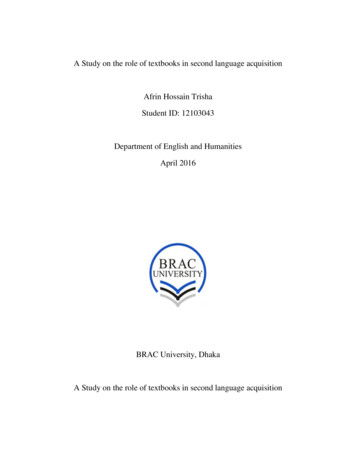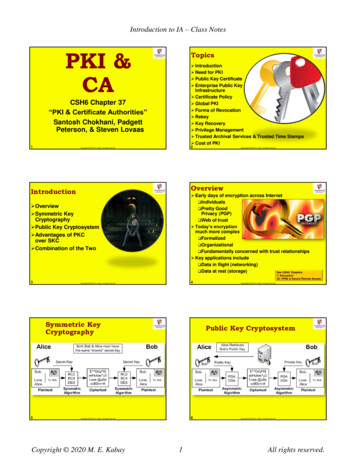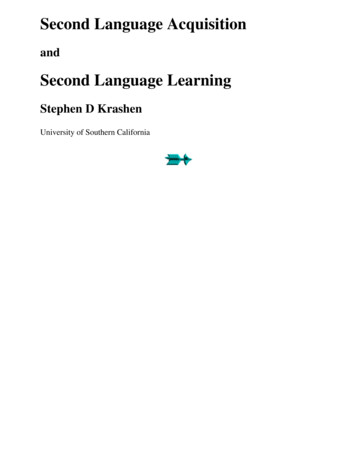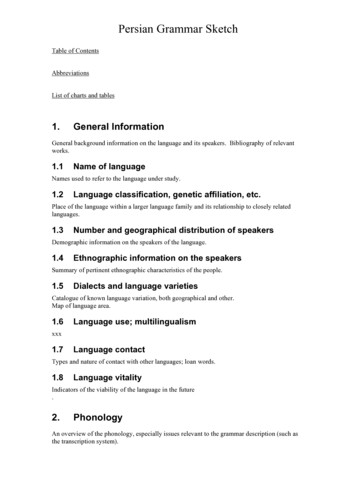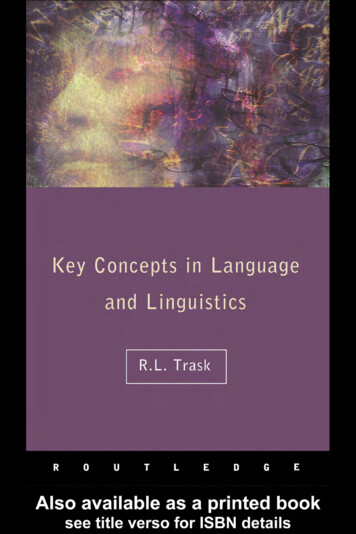
Transcription
KEY CONCEPTS IN LANGUAGE ANDLINGUISTICS‘This is brilliant book. It combines the readability of Pinker with thebreadth and erudition of Crystal, and deserves a place of honour as asummary of the best of twentieth-century linguistics—liberal,scholarly, forward-looking, undogmatic, sensible, practical andabove all wide ranging. Every linguist will be pleased with most ofit and every student will cling to it and love it.’Richard Hudson, University College LondonKey Concepts in Language and Linguistics is an A-Z guide to the main terms andconcepts used in the study of language and linguistics. The book includesdefinitions of: terms used in grammatical analysis from phoneme to componential analysis; branches of linguistics from semantics to neurolinguistics; approaches used in studying language from critical discourse analysis toSystemic Linguistics; linguistic phenomena from code-switching to conversational implicature; language varieties from pidgin to standard language.Each entry begins with a brief definition of the term followed by a more detaileddescription. Entries trace the origin of the concept, mention the key associatedindividuals, provide a guide to further reading and are extensively crossreferenced.R.L.Trask is Professor of Linguistics at the University of Sussex. His numerouspublications include The History of Basque (1996), Language: The Basics(1995), A Dictionary of Phonetics and Phonology (1995) and A Dictionary ofGrammatical Terms (1993).
KEY CONCEPTS SERIESOther titles available from RoutledgeKey Concepts in Communication and Cultural Studies (second edition) TimO’Sullivan, John Hartley, Danny Saunders, Martin Montgomery and John FiskeKey Concepts in Cinema StudiesSusan HaywardKey Concepts in Post-Colonial StudiesBill Ashcroft, Gareth Griffit hs and Helen TiffinKey Concepts in Popular MusicRoy Shuker
KEY CONCEPTS INLANGUAGE ANDLINGUISTICSR.L.TraskLondon and New York
First published 1999by Routledge11 New Fetter Lane, London EC4P 4EESimultaneously published in the USA and Canadaby Routledge29 West 35th Street, New York, NY 10001 1999 R.L.TraskReprinted 1999Routledge is an imprint of the Taylor & Francis GroupThis edition published in the Taylor & Francis e-Library, 2005.“To purchase your own copy of this or any of Taylor & Francis or Routledge’s collection ofthousands of eBooks please go to www.eBookstore.tandf.co.uk.”All rights reserved. No part of this book may be reprinted orreproduced or utilized in any form or by any electronic,mechanical, or other means, now known or hereafter invented,including photocopying and recording, or in any informationstorage or retrieval system, without permission in writing fromthe publishers.British Library Cataloguing in Publication DataA catalogue record for this book is available from the BritishLibraryLibrary of Congress Cataloguing in Publication DataTrask, R.L. (Robert Lawrence) 1944–Key concepts in language and linguistics / R.L.Trask.p. cm. (Key concepts)Includes bibliographical references and index.ISBN 0-415-15741-2 (HB). —ISBN 0-415-15742-0 (PB).1. Linguistics—Dictionaries. I. Title. II. Series.P29.T687 1998410′.3–dc21 98–24025CIPISBN 0-203-29906-X Master e-book ISBNISBN 0-203-26534-3 (Adobe eReader Format)ISBN 0-415-15742-0 (Print Edition) (Pbk)ISBN 0-415-15741-2 (Hbk)
CONTENTSPreface and acknowledgementsviList of Key ConceptsviiiKEY CONCEPTS1Bibliography232Index243
PREFACEThe book in your hand is neither a dictionary nor an encyclopedia, but somethingin between. As its title suggests, it provides fairly detailed coverage of nearly 300key concepts in the study of language. The named concepts selected for inclusionare all among the most important in the field, and among those which everybeginning student is likely to encounter.The concepts are taken from every area of language study, from traditionalgrammar to contemporary grammatical theory, from child language to languageand brain, from lexicography to the linguistic study of literary texts, from men’sand women’s speech to language and power. Each entry provides a briefdefinition of the term entered and then goes on to explain the concept in somedetail—often with numerous examples— and it also introduces and explainsrelated terms, which are given in bold italics. Wherever possible, the historicalorigins of the concept are described, including the time of introduction and thenames of individuals who have made the concept prominent. When a concept iscontroversial, the entry says so. Cross-references to other concepts with theirown entries are frequent, and are always given in boldface. In most cases, theentry concludes with cross-references to other entries which are related, and witha list of suggested further reading, usually arranged from briefest and mostelementary to most advanced and comprehensive. A complete bibliography ofthe suggested reading is provided after the main part of the book. Where little orno further reading is suggested, this usually means that the concept, thoughfundamental, is often maddeningly difficult to look up in textbooks, and here Ihave been at pains to provide the kind of explanation not readily availableelsewhere.At the front of the book you will find an alphabetical list of all the conceptswith their own entries. At the end, you will find a detailed index; this includes notonly the terms entered as headwords but also all other terms introduced withinentries. So, if you don’t find the term you’re looking for in the main list, be sureto check the index, which includes hundreds of additional terms. The index alsoincludes references to individuals named in the entries.I hope that this book will prove to be of great utility to students undertakingthe study of almost any aspect of language for the first time, either atundergraduate level or at post-graduate level.
viiAcknowledgementsI am indebted to Kieron Corless for inviting me to write this book, and to NicolaWoods, Lyn Pemberton and Richard Coates for various types of advice andassistance in the writing of it.R.L.TraskBrighton, UKOctober 1997
KEY eam mechanismalternationambiguityanalogyanaphoranimal communicationanthropological linguisticsaphasiaapparent timeapplied linguisticsarbitrarinessargumentartificial languageaspectautonomy of language
ixauxiliaryBbasic word orderbehaviourismbilingualismbioprogram hypothesisBlack EnglishCcaregiver speechcaseclausecode-switchingcognitive linguisticscognitive sciencecoherencecohesioncolloquial speechcommunicative competencecomparative reconstructioncompetencecomplementcomponential analysiscomputational ent structure
xcontrolconversational implicatureconversation analysiscooperative principlecoordinate structurecopulacorpuscreolecritical discourse analysiscritical period hypothesisDdead languagedeep structuredeficit hypothesisdeictic mdesign sediscourse analysisdisplacement
xidistinctive featuredistributionduality of patterningdyslexiaEellipsisentailmentethnography of speakingetymologyexperimental approachFfinitefocusfolk linguisticsfunctionalismfunctions of languageGgapgendergenerative grammargenetic hypothesis of languagegenetic -Binding Theorygrammar
xiigrammatical categorygrammatical relationgraphemeHheadhistorical linguisticsIiconicityidiomimmigrant languageIndo-Europeaninflectioninnateness hypothesisinternal reconstructioninternational languageInternational Phonetic AlphabetintertextualityintonationintuitionKkinship termsknowledge about languageLlanguagelanguage acquisitionlanguage acquisition devicelanguage and ethnicitylanguage and identity
xiiilanguage and ideologylanguage and powerlanguage areaslanguage changelanguage contactlanguage deathlanguage disabilitylanguage facultylanguage familylanguage instinctlanguage in uselanguage mythslanguage planninglanguage processinglanguelateralizationLexical-Functional Grammarlexicographylexiconlingua francalinguistic arealinguistic relativity hypothesislinguisticslinguistic signliteracyloan wordlocalizationlogonomic rules
xivMmanner of nguagemetaphorminimal pairminority hologymovementNnamenarrativenational languagenatural classnatural languagenatural-language tionnon-verbal communication
xvnotational conventionnounnoun phrasenumbernumber of languagesOofficial languageonomasticsopen-endednessoracyorigin and evolution of languageorthographyPparadigmparadigmatic relationparalanguageparolepart of speechperceptual osophy of languagephonation typephonemephonetics
xviphonologyphonotacticsphrasephrase-structure grammarpidginplace of rosodyproto-languageprotolanguage tative approachquantitative approachRraisingreconstructionrecursionreference
xviirootruleSsandhiSaussurean paradoxsegmentselection restrictionsemantic rolesemanticssemioticssensesense relationsentencesex differences in languagesexist languagesign languageslangsocial history of languagesocial stratification of languagesociolinguisticssound symbolismspeechspeech actspeech communityspeech eventspeech soundspellingstandard language
subordinationsuprasegmentalsurface structuresyllablesymbolic systemsynchronysyntactic categorysyntagmatic relationsyntaxsystemsystematic correspondenceSystemic LinguisticsTtensetexttext linguisticstextualitytone languagetopictraditional grammar
xixtranscriptiontransformational aluniversal grammarusageutteranceVvariationverbverb phrasevernacularvocal mationwriting system
Aaccent A particular way of pronouncing a language. For any language with morethan a handful of speakers, there are prominent regional, social and individualdifferences in the way the language is pronounced by different people;sometimes these differences are dramatic. Each distinguishable type ofpronunciation is called an accent. Depending on where we come from and whatexperience we have, we will be able to identify accents different from our own withmore or less precision: in the case of English this may be an American accent, aDeep South accent, a Scottish accent, a working-class London accent, a Frenchaccent (from a non-native speaker) and so on. Speakers of all languages can dothe same.It is important to realize that everybody has an accent: it is not possible tospeak a language without using some accent or other. Of course, every one of usregards some accents as more familiar than others, or as more prestigious thanothers, but that is a different matter: we are merely more sensitive to accentswhich differ strongly from our own. A friend of mine with an impeccable middleclass south-of-England accent which attracts no attention in London once visitedYorkshire, where a wide-eyed little girl, after listening to him for a few minutes,finally confided to him, in a broad Yorkshire accent, ‘Ee—tha talks funny.’In Britain, the single most prestigious accent is Received Pronunciation, orRP, an accent which seems to have arisen in the prestigious ‘public schools’(private schools) in the nineteenth century. This accent is not associated with anyparticular region, though it is structurally most similar to certain accents of thesoutheast of England. No more than three per cent of Britons speak with an RPaccent, though many more have a near-RP accent which differs only in a fewparticulars. RP is the accent usually taught to foreign learners of English inBritain. Nevertheless, regional and social variation in accents in Britain is verygreat, greater than anywhere else in the English-speaking world, and the urbanaccents of Newcastle, Glasgow or Liverpool may be unintelligible to outsiders.In the USA, distinctive and readily identifiable regional accents of English areconfined to New England, the east coast and the south, the areas which havebeen settled longest. West of the Appalachians, the differences level out into thegreat continuum of General American accents, with minimal local variationapart from a few large cities.
2 KEY CONCEPTS IN LANGUAGE AND LINGUISTICSRegional accents of English are prominent in Ireland, less so in the Caribbean,still less so in Canada, and least prominent of all in the southern Hemispherecountries, the most recent to be settled.A conspicuous difference among accents of English is that between rhotic andnon-rhotic accents. In a rhotic accent, the historical /r/ is retained in all positions,so that farther does not sound like father and tar does not rhyme with Shah. In anon-rhotic accent, the historical /r/ has been lost everywhere except before a vowel,and so farther sounds just like father and tar does rhyme with Shah.A striking way of testing accents is to check whether certain pairs of words arepronounced identically or differently. Here are some useful pairs; in each case,the words are pronounced identically by some speakers but differently by others:horse/hoarse, threw/through, dew/do, nose/knows, pull/pool, poor/ pour, whine/wine, winter/winner, court/caught, caught/cot, farther/ father, god/guard, hair/air, three/free, stir/stare, buck/book, higher/ hire, marry/merry/Mary.Observe that, in the USA, an accent is usually considered to be just one aspectof a dialect; in Britain, the two are regarded as largely independent, at least inprinciple.(Note that the word accent is also used, very informally, to mean diacritic:one of the little marks placed on a letter to indicate something about itspronunciation, as in café, learnèd, bête noire and Zoë.)See: dialect; phonologyFurther reading: P.Hawkins (1984: ch. 8), Hughes and Trudgill (1996),Trudgill and Hannah (1994), Wells (1982)adjective The part of speech which includes words like big and beautiful.English and many other languages have a large and growing class of adjectives,though in still other languages the class of adjectives is tiny and closed or absentaltogether. (In these languages, the meanings expressed by adjectives in Englishare expressed by other parts of speech.)In English, adjectives may be identified by a number of criteria. Not everyadjective exhibits every single one of the typical adjectival properties, but a wordthat exhibits most of them must still be classed as an adjective. Here are sometests for adjectives.Distribution: An adjective can typically appear in each of the following slotsto produce a good sentence: This is a(n) — book; This book is —; — though thisbook is, it’s not what we want. (Try this with new, interesting, expensive,beautiful.)Comparison: An adjective can be compared in one of the following two ways:big/bigger/biggest; beautiful/more beautiful/ most beautiful. It can also appear inthe as as construction: as pretty as Lisa.Degree: An adjective can be modified by a degree modifier like very, fairly,too, so or rather, very big, fairly nice, so good, rather interesting.Affixation: An adjective may take the prefix un- or in- to form anotheradjective, the suffix -ly to form an adverb, or the suffix -ness or -ity to form a
KEY CONCEPTS IN LANGUAGE AND LINGUISTICS 3noun, among other possibilities: happy / unhappy / happily / happiness; possible /impossible / possibly/possibility.Negative properties: An adjective cannot be marked for number (singularversus plural) or for tense (past versus non-past), nor can it take the suffix -ingwhich goes onto verbs.The meaning of an adjective is most typically a temporary or permanent stateor condition: big, human, young, red, happy, drunk, shiny, intelligent, asleep.Many adjectives express subjective perceptions, rather than objective facts:interesting, beautiful, disgusting. A few adjectives express very unusual types ofmeaning: mere, utter, the heavy of She’s a heavy smoker.See: adverb; part of speechFurther reading: Collins Cobuild, 1990: ch. 2; Crystal, 1996: units 48–51;Greenbaum and Quirk, 1990: ch. 7; Hurford, 1994: 8–10.adverb The part of speech which includes words like soon and slowly. Englishhas a fairly large class of adverbs, as do many other languages (though not all).Most commonly, an adverb describes the circumstances of an action: where it isdone (here, elsewhere, overhead), when it is done (tomorrow, often, rarely,never) or how it is done (fast, well, carefully, dramatically, resentfully). Butsome adverbs have less usual kinds of meaning, and, as always, we can onlyidentify adverbs with confidence by their grammatical properties.A typical property of adverbs is their position in the sentence. Consider thesentence She poured the wine. A typical adverb like carefully can be inserted intoany one of three positions: Carefully she poured the wine; She carefully pouredthe wine; She poured the wine carefully. The same is true of many other adverbs,like often, angrily and skilfully. But not all adverbs are so flexible: yesterday anddownstairs can only fit into the first and third of these positions, while fast canonly fit into the last. (Naturally, some adverbs, such as uphill, have meaningswhich do not allow them to fit sensibly into this example, but consider anotherexample like She threw the ball .) Adverbs with negative or interrogativemeanings do something odd when they come first: we can’t say * Seldom shepoured the wine or *Why she poured the wine? but must say instead Seldom didshe pour the wine and Why did she pour the wine? (the asterisk marksungrammaticality).Two other typical properties of adverbs are their ability to be compared withmore or most and their ability to be modified by words expressing degree, suchas very, rather, too and so: more carefully, most often, very skilfully, rathercasually, too fast, so well. This is usually only possible with adverbs describinghow something is done, though there are a few exceptions, like often. Theseadverbs can also appear in the as as construction, as in Susie drives as well asEsther.Adverbs have few other grammatical properties. They never change their formfor any reason at all: for example, they cannot be marked for tense, and theyhave no separate plural form.
4 KEY CONCEPTS IN LANGUAGE AND LINGUISTICSEnglish has a subclass of adverbs, called sentence adverbs, which are ratherdifferent from ordinary adverbs. While ordinary adverbs describe some aspect ofthe action, the sentence adverbs express the speaker’s view of the whole rest ofthe sentence. For example, in She probably poured the wine, the sentence adverbprobably says nothing about her pouring of the wine, but rather expresses thespeaker’s view of the likely truth of the statement She poured the wine. Othersentence adverbs are maybe, certainly, frankly, mercifully, honestly, hopefullyand fortunately. Some of these can also be used as ordinary adverbs: compareFrankly, she must tell us about it (sentence adverb expressing the speaker’sview) with She must tell us about it frankly (ordinary adverb describing hertelling). There is almost never any ambiguity.Observe that many adverbs describing how something is done (the adverbs ofmanner) are derived from adjectives by means of the suffix -ly: eager/eagerly,furious/furiously. But other adverbs, including adverbs of time and adverbs ofplace, are usually simple words, not derived from anything.Earlier grammarians often had the bad habit of assigning the label ‘adverb’ toalmost any troublesome word they didn’t know what to do with, such as not,almost and very. Some dictionaries and other books still continue thisunfortunate practice today, but in fact these words do not behave like adverbsand are not adverbs: some of them (like very) belong to other parts of speechentirely, while others (like not) exhibit unique behaviour and cannot be sensiblyassigned to any part of speech at all.See: adjective; part of speechFurther reading: Collins Cobuild, 1990: ch. 6; Crystal, 1996: units 52–58;Greenbaum and Quirk, 1990: ch. 7; Hurford, 1994: 10–13.affix A grammatical element which cannot form a word by itself. Most (but notall) of the world’s languages contain grammatical affixes used for variouspurposes. English has fewer affixes than some other languages, but it still hassome. For example, nouns exhibit the plural affix -s, as in singular dog but pluraldogs, while adjectives exhibit the comparative affix -er and the superlative affix-est, as in wide, under, widest.Verbs in English exhibit a somewhat larger number of affixes, as shown bypaint, which has grammatical forms like paints (She paints pictures), painted(She painted a picture) and the quite different (She has painted a picture) andpainting (She is painting a picture). Other affixes can be added to the verb paintto obtain the verb repaint and the nouns painter and painting (as in This is a nicepainting).An affix that goes on the end, like -s and -ing, is a suffix, while one that goeson the beginning, like re-, is a prefix. Other types of affix exist, such as infixes:observe that the Tagalog verb sulat ‘write’ has inflected forms sumulat ‘wrote’and sinulat ‘was written’, with infixes -um- and -in- inserted into the middle ofthe verbal root. There are also superfixes, which are placed ‘on top of’ a word:note the English nouns 'record and 'contest, distinguished from the related verbsre’cord and con'test only by a change in the placement of the stress.
KEY CONCEPTS IN LANGUAGE AND LINGUISTICS 5See: derivation; inflection; morphemeFurther reading: Bauer, 1988: ch. 3; Katamba, 1994: ch. 4.agreement The grammatical phenomenon in which the form of one word in asentence is determined by the form of another word which is grammaticallylinked to it. Agreement, which is also called concord, is an exceedingly commonphenomenon in languages generally, but it is not present equally in all of them.Swahili, Russian, Latin and German have a great deal of agreement; French andSpanish have somewhat less; English has very little; Chinese has none at all.Certain types of agreement are especially frequent. A finite verb may agree inperson and number with its subject. This happens in Basque; here are thepresent-tense forms of joan ‘go’ (the pronouns are in brackets since they areoptional):(ni) noa(hi) hoaAna doa(gu) goaz(zu) zoaz(zuek) zoazteNeskak doaz‘I go’‘you go’‘Ann goes’‘we go’‘you go’‘you go’‘The girls go’(singular intimate)(singular polite)(plural)In each case the form of the verb marks the subject as first, second or thirdperson and as singular or plural, and we say that the verb-form agrees with thesubject in person and number. As you can see from the English glosses, Englishhas only a tiny amount of agreement of this kind: only the third-singular goes isexplicitly distinguished, all other persons and numbers taking an invariable go.Much less frequently, a verb may agree in person and number with its object.This also happens in Basque. The form (zuk) (ni) ikusi nauzu ‘you saw me’carries agreement both for the subject ‘you’ (-zu) and for the object ‘me’ (n-);compare (zuk) (gu) ikusi gaituzu ‘you saw us’ and neskek (ni) ikusi naute ‘thegirls saw me’.Adjectives and determiners may agree in number with their head noun. Basquedoes not have this, but Spanish does: compare la casa vieja ‘the old house’ withlas casas viejas ‘the old houses’, in which both the determiner la(s) ‘the’ and theadjective vieja(s) ‘old’ show agreement with singular casa ‘house’ and pluralcasas ‘houses’. As the English glosses suggest, this kind of agreement isgenerally absent from English, but we do have a trace of it in cases like this oldhouse versus these old houses, in which the determiner agrees (but not theadjective).A determiner or an adjective may also agree in case with its head noun. Thisoccurs in German: in mit diesem Mann(e) ‘with this man’ (the e is optional and istherefore in brackets), the noun Mann(e) stands in the dative case, and thedeterminer diesem ‘this’ agrees with it in case, while in für diesen Mann, Mannstands in the accusative case, and the determiner now agrees with that.
6 KEY CONCEPTS IN LANGUAGE AND LINGUISTICSThe Spanish and German examples also illustrate what might be calledagreement in gender. For example, the Spanish noun casa ‘house’ is feminine ingender; if we use instead a masculine noun, such as libro ‘book’, we get el libroviejo ‘the old book’ and los libros viejos ‘the old books’, showing that thedeterminer and the adjective are ‘agreeing’ in gender as well as in number. Suchgender matching is traditionally regarded as another variety of agreement;strictly speaking, however, this is not agreement but government, since a singlenoun like casa or libro has only one possible gender, and hence in these cases itis not the form of the noun which determines the forms of the other words, butits very presence—the defining criterion for government. Some linguists apply tosuch cases the label governmental concord.See: governmentFurther reading: Hurford, 1994:13–14.airstream mechanism Any way of producing a stream of air for use in speech.We produce speech by using our vocal organs to modify a stream of air flowingthrough some part of the vocal tract, and all speech sounds require this airstreamfor their production. There are several very different ways of producing anairstream, only some of which are used in languages, and only one of which isused in all languages.To begin with, an airstream may be either egressive (flowing out of themouth) or ingressive (flowing into the mouth). Further, the air which is movingmay be lung air (this is the pulmonic mechanism), pharynx air (the glottalicmechanism) or mouth air (the velaric mechanism). This gives six possiblecombinations, only four of which are used in speech.In the pulmonic egressive airstream mechanism, air is squeezed out of thelungs by the diaphragm and the rib muscles and passes out through the mouth(and possibly the nose). This is the principal mechanism in all languages and theonly one used in most languages (including English). In the pulmonic ingressivemechanism, air is drawn in from the outside through the mouth into the lungs; nolanguage uses this, but you may hear it intermittently from a child sobbing andtalking at the same time.In the glottalic egressive mechanism, the glottis is closed and the larynx isdriven up in the throat like a piston, pushing the air of the pharynx out throughthe mouth. The sounds produced are ejectives, which occur in only a fewlanguages. If the larynx is driven downward instead, outside air is pulled into themouth and pharynx, and we have the glottalic ingressive mechanism. The soundsproduced are injectives (or voiceless implosives); these are very rare in their pureform, but, if the glottis is left open slightly, so that air can leak out from thelungs, we get a complex ingressive-egressive mechanism, producing voicedimplosives, which are much commoner.In the velaric egressive mechanism, the back of the tongue is pressed againstthe velum and another closure is made in front of this; the tongue body is pushedup, so that, when the front closure is released, mouth air is driven outward. Theresulting sounds are reverse clicks, which do not occur in any language. If,
KEY CONCEPTS IN LANGUAGE AND LINGUISTICS 7instead, the tongue body is pulled downward, when the front closure is released,air is pulled into the mouth; this is the velaric ingressive mechanism, and theresulting sounds are clicks. Clicks occur as speech sounds in some languages ofsouthern Africa; elsewhere, these sounds occur only paralinguistically, as in theEnglish tsk tsk noise and as in the sound of a kiss made with the lips tightlypursed.There is one other airstream mechanism, which is very unusual. Persons whohave had their larynxes removed surgically can learn to produce an airstream byswallowing air and then forcing it up through the oesophagus; this oesophagicegressive airstream is effectively a controlled belch.See: phonation typeFurther reading: Crystal, 1997a: ch. 22; Ladefoged and Maddieson, 1996:section 3.2; Laver, 1994: ch. 6.alternation A variation in the form of a linguistic element depending on where itoccurs. Certain English nouns ending in the consonant /f/ form their plurals with /v/ instead: leaf but leaves, knife but knives. We say that such items exhibit an /f/—/v/ alternation. For most (not all) speakers a similar alternation occurs insingular house (with /s/) but plural houses (with /z/), though here our spellingsystem does not represent the alternation explicitly.A somewhat different sort of alternation is found in related words like electric(which ends in /k/) and electricity (which has /s/ instead of /k/ in the sameposition).More subtle is the three-way alternation occurring in the English pluralmarker. The noun cat has plural cats, pronounced with /s/, but dog has pluraldogs, pronounced with /z/ (though again the spelling fails to show this), and foxhas plural foxes, with /z/ preceded by an extra vowel. This alternation is regularand predictable; the choice among the three alternants (as they are called) isdetermined by the nature of the preceding sound.Alternations are exceedingly common in the world’s languages, and they areoften of great interest to linguists trying to produce elegant descriptions oflanguages.See: sandhiFurther reading: Bloomfield, 1933: ch. 13; Hockett, 1958: ch. 33;Sommerstein, 1977:41–45.ambiguity Two or more sharply distinct meanings for a single string of words. Thesimplest type of ambiguity is a lexical ambiguity, which results merely from theexistenc
Key Concepts in Language and Linguistics is an A-Z guide to the main terms and concepts used in the study of language and linguistics. The book includes definitions of: terms used in grammatical analysis from phoneme to componential analysis; branches of





